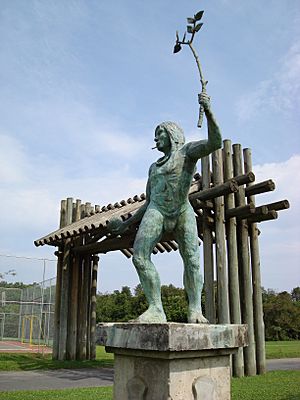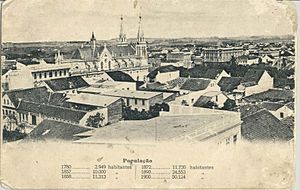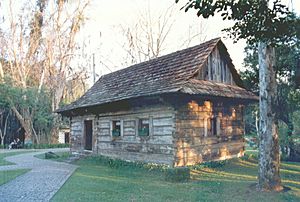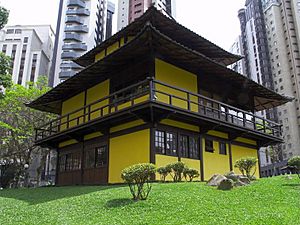History of Curitiba facts for kids
The history of Curitiba has many interesting periods, showing how the city grew from a forest into a big urban center.
Contents
Early Times: Indigenous Period
Long ago, the area where Curitiba now stands was a thick forest filled with Paraná pine trees. The very first people to live here were an indigenous tribe called the Tingüi, part of the Tupi-Guarani nation.
Around the start of the Common Era, the Curitiba Plateau (also known as the First Plateau of Paraná) was home to "potter peoples." These were groups who made pottery. Archaeologists have found underground houses near Curitiba. These homes show how these early people adapted to the cold weather, frost, and even snow.
When the Portuguese first arrived in Brazil, the Curitiba Plateau was home to different indigenous groups, including those from the Jê and Tupi-Guarani language families.
Becoming a City: Colonization Period
The early 16th century saw the start of a conflict between Europeans and the indigenous people in southern Brazil. Portuguese and Spanish explorers came looking for valuable gold and stones, and also to enslave native people.
Around 1630, people from Paranaguá began settling the Curitiba region. They had found gold there. This led to the formation of a small village called "Our Lady of Light and Good Jesus of Pine Forest." This village officially became a town in 1693. The Portuguese founders named it Vila da Nossa Senhora da Luz dos Pinhais (which means "Our Lady of the Light in the Pine Forest"). The name was later changed to Curitiba in 1721.
There's a legend about how Curitiba got its name. It says that around 1648, a group of pioneers were looking for gold and started a small village near the Atuba River. They really respected Nossa Senhora da Luz (Our Lady of Light) and made a special place for her statue. The legend says that every morning, the statue's eyes would turn towards a pine tree forest. The pioneers knew this forest was sacred to the local Indians. They took this as a sign that Nossa Senhora was showing them a special place for their village.
Even though the Indians saw them as enemies, the pioneers bravely went into the forest. A miracle happened: the Indians were peaceful and seemed to be expecting them! The leader of the Tingüi tribe, cacique Tindiqüera, supposedly showed them a new spot and put a stick in the ground, saying "Coré Etuba" (which means "many pines"). The legend says a great tree grew from this stick, and that's where the "zero mark" of Curitiba is today. At that spot, the pioneers built a chapel for the saint, now called Nossa Senhora da Luz dos Pinhais.
Curitiba officially became a town in 1812, spelled as Curityba. Another spelling, Coritiba, also appeared and became popular in newspapers and government papers. However, a state rule in 1919 settled the debate, making Curitiba the official spelling.
The city grew thanks to the cattle trade. It was a key stop between cattle farms in the South and markets in the North. Curitiba really started to develop in the early 19th century with the growing and selling of Yerba mate. It became a full city in 1842.
New Arrivals: Immigration Period
After 1850, many European immigrants began arriving in Curitiba. The main groups were from Germany, Italy, Poland, and Ukraine. In 1853, the southern part of São Paulo province separated to form the new province of Paraná, and Curitiba became its capital. The Universidade Federal do Paraná (Federal University of Paraná), which was the first university in Brazil, opened in Curitiba in 1913. That same year, electric streetcars started running in the city.
Like most of Southern Brazil, Curitiba's population is mostly made up of Brazilians with European roots. The first Europeans were Portuguese, arriving in the 17th century. They married into the native people and also with African slaves.
In the 19th century, even more immigrants came from Europe. The first German immigrants settled in Paraná in 1828. However, large numbers of Germans only arrived in Curitiba in the 1870s. Many of them were Volga Germans, who had lived in Russia.
Polish immigrants first arrived in 1871. They settled in farming areas near Curitiba and greatly influenced the region's agriculture. Curitiba has the second largest Polish community outside of Poland, after Chicago. It's also the only Brazilian city that has its name spelled in Polish: Kurytyba.
Italian immigrants started coming to Curitiba in 1878. Most came from the Veneto and Trento regions in Northern Italy. They mainly settled in the Santa Felicidade neighborhood, which is still a big center for the Italian community today.
Many Ukrainian immigrants settled in Curitiba, especially between 1895 and 1897, when about 20,000 arrived. They were farmers from Galicia who came to Brazil to become small farmers. Today, there are about 300,000 Ukrainian-Brazilians living in Paraná.
Japanese immigrants began arriving in the region in 1915. Curitiba received a good number of immigrants from Japan. Now, about 40,000 Japanese-Brazilians live in the city.
Other groups also settled in Curitiba, including Jewish people, Arabs from Lebanon and Syria, English, French, Russians, and other Eastern Europeans.
Modern Times: Current Period
During the 20th century, especially after the mid-1900s, Curitiba's population grew a lot. The city became a major center for trade and services, making it one of Brazil's richest cities. It also became known for its new ideas in urban planning. In the 1940s and 1950s, Alfred Agache, a city planning expert from France, was hired to create the first city plan. This plan focused on a "star" shape of boulevards, with public services downtown, an industrial area, and good sanitation. Parts of it were followed, but it was too expensive to finish.
By the 1960s, Curitiba's population reached 430,000. Some people worried that this fast growth would change the city too much. In 1964, Mayor Ivo Arzua asked for new ideas for city design. Architect Jaime Lerner, who later became mayor himself, led a team from the Universidade Federal do Paraná. They suggested strict rules to control how the city spread out, reducing traffic downtown, protecting Curitiba's Historic Sector, and creating a good and affordable public transport system.
This plan, called the Curitiba Master Plan, was adopted in 1968. Lerner closed XV de Novembro Street to vehicles because it had so many pedestrians. The plan also introduced a new road design to reduce traffic: the Trinary Road System. This system uses two one-way streets going in opposite directions, with a smaller, two-lane street in the middle just for express buses. Five of these roads form a star shape that leads to the city center. Areas farther from these main roads are planned for less dense development, to keep traffic away from the main routes. Also, many areas that used to flood were turned into parks.
Today, fewer foreigners are moving to Curitiba. Instead, many Brazilians from other parts of the country are moving there. It's estimated that about half of Curitiba's population now consists of migrants from other regions of Brazil.
Images for kids
-
Frost in Curitiba.
-
Federal University of Paraná was the first university opened in Brazil.
-
Musicians at the Feirinha do largo da ordem.






























